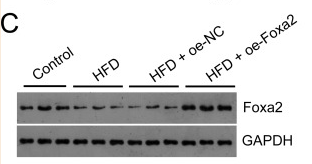FOXA2 Antibody - #DF13363
| Product: | FOXA2 Antibody |
| Catalog: | DF13363 |
| Description: | Rabbit polyclonal antibody to FOXA2 |
| Application: | WB IHC |
| Cited expt.: | WB |
| Reactivity: | Human, Mouse, Rat |
| Prediction: | Pig, Zebrafish, Bovine, Horse, Sheep, Rabbit, Dog, Chicken |
| Mol.Wt.: | 48kDa; 48kD(Calculated). |
| Uniprot: | Q9Y261 |
| RRID: | AB_2846382 |
Related Downloads
Protocols
Product Info
*The optimal dilutions should be determined by the end user.
*Tips:
WB: For western blot detection of denatured protein samples. IHC: For immunohistochemical detection of paraffin sections (IHC-p) or frozen sections (IHC-f) of tissue samples. IF/ICC: For immunofluorescence detection of cell samples. ELISA(peptide): For ELISA detection of antigenic peptide.
Cite Format: Affinity Biosciences Cat# DF13363, RRID:AB_2846382.
Fold/Unfold
Forkhead box A2; Forkhead box protein A2; FOX A2; foxa2; FOXA2_HUMAN; Hepatic nuclear factor 3 beta; Hepatocyte nuclear factor 3; Hepatocyte nuclear factor 3 beta; Hepatocyte nuclear factor 3-beta; HNF 3B; HNF-3-beta; HNF-3B; HNF3B; MGC19807; TCF 3B; TCF-3B; TCF3B; Transcription factor 3B;
Immunogens
A synthesized peptide derived from human FOXA2, corresponding to a region within C-terminal amino acids.
- Q9Y261 FOXA2_HUMAN:
- Protein BLAST With
- NCBI/
- ExPASy/
- Uniprot
MLGAVKMEGHEPSDWSSYYAEPEGYSSVSNMNAGLGMNGMNTYMSMSAAAMGSGSGNMSAGSMNMSSYVGAGMSPSLAGMSPGAGAMAGMGGSAGAAGVAGMGPHLSPSLSPLGGQAAGAMGGLAPYANMNSMSPMYGQAGLSRARDPKTYRRSYTHAKPPYSYISLITMAIQQSPNKMLTLSEIYQWIMDLFPFYRQNQQRWQNSIRHSLSFNDCFLKVPRSPDKPGKGSFWTLHPDSGNMFENGCYLRRQKRFKCEKQLALKEAAGAAGSGKKAAAGAQASQAQLGEAAGPASETPAGTESPHSSASPCQEHKRGGLGELKGTPAAALSPPEPAPSPGQQQQAAAHLLGPPHHPGLPPEAHLKPEHHYAFNHPFSINNLMSSEQQHHHSHHHHQPHKMDLKAYEQVMHYPGYGSPMPGSLAMGPVTNKTGLDASPLAADTSYYQGVYSRPIMNSS
Predictions
Score>80(red) has high confidence and is suggested to be used for WB detection. *The prediction model is mainly based on the alignment of immunogen sequences, the results are for reference only, not as the basis of quality assurance.
High(score>80) Medium(80>score>50) Low(score<50) No confidence
Research Backgrounds
Transcription factor that is involved in embryonic development, establishment of tissue-specific gene expression and regulation of gene expression in differentiated tissues. Is thought to act as a 'pioneer' factor opening the compacted chromatin for other proteins through interactions with nucleosomal core histones and thereby replacing linker histones at target enhancer and/or promoter sites. Binds DNA with the consensus sequence 5'-[AC]A[AT]T[AG]TT[GT][AG][CT]T[CT]-3' (By similarity). In embryonic development is required for notochord formation. Involved in the development of multiple endoderm-derived organ systems such as the liver, pancreas and lungs; FOXA1 and FOXA2 seem to have at least in part redundant roles. Originally described as a transcription activator for a number of liver genes such as AFP, albumin, tyrosine aminotransferase, PEPCK, etc. Interacts with the cis-acting regulatory regions of these genes. Involved in glucose homeostasis; regulates the expression of genes important for glucose sensing in pancreatic beta-cells and glucose homeostasis. Involved in regulation of fat metabolism. Binds to fibrinogen beta promoter and is involved in IL6-induced fibrinogen beta transcriptional activation.
Phosphorylation on Thr-156 abolishes binding to target promoters and subsequent transcription activation upon insulin stimulation.
Nucleus. Cytoplasm.
Note: Shuttles between the nucleus and cytoplasm in a CRM1-dependent manner; in response to insulin signaling via AKT1 is exported from the nucleus.
Research Fields
· Human Diseases > Endocrine and metabolic diseases > Maturity onset diabetes of the young.
· Organismal Systems > Aging > Longevity regulating pathway - multiple species. (View pathway)
References
Application: WB Species: Mouse Sample:
Restrictive clause
Affinity Biosciences tests all products strictly. Citations are provided as a resource for additional applications that have not been validated by Affinity Biosciences. Please choose the appropriate format for each application and consult Materials and Methods sections for additional details about the use of any product in these publications.
For Research Use Only.
Not for use in diagnostic or therapeutic procedures. Not for resale. Not for distribution without written consent. Affinity Biosciences will not be held responsible for patent infringement or other violations that may occur with the use of our products. Affinity Biosciences, Affinity Biosciences Logo and all other trademarks are the property of Affinity Biosciences LTD.


